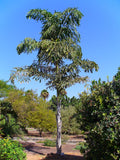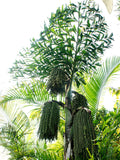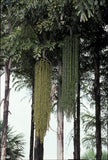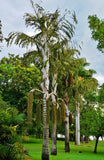Giant Mountain Fishtail Palm (Caryota maxima) Seeds – Grow a Legend
Grow something epic: from one of the most dramatic fishtail palms comes Caryota maxima, often called the Giant Mountain Fishtail Palm or Himalayan Fishtail Palm. Planting these seeds is planting not just a palm, but a living story of grandeur, resilience, and wild beauty.
🌴 What Makes Caryota maxima So Special
-
Monumental size & growth habit: This is a solitary palm (one main trunk), capable of astonishing growth—up to ~2 meters (6.5 feet) in a year under ideal conditions. Eventually reaching heights of 25–33 m (80-110 feet) with a trunk diameter of up to 30 cm (12 in).
-
Leaves & foliage: Doubly pinnate (bipinnate) leaves with pendulous leaflets that have a fishtail-shape, often toothed or “praemorse” at the tips. The leaflets hang in one plane, drooping gracefully.
-
Inflorescences & fruit: When mature, it sends forth massive pendant flower structures (~1-1.5 m long), with both male and female flowers on the same inflorescence. The flowers are not showy in a typical petal sense but are elegant in structure; the fruits mature from green to pink to dark reddish-purple.
🌡 Hardiness & Growing Conditions
-
USDA Hardiness Zones: Zones 8b through 11. The variety known as Caryota maxima ‘Himalaya’ is especially cold-tolerant—reports say it can survive down to about 19°F (-7°C).
-
Tolerance: It thrives in tropical to subtropical climates, but because of its mountain origins, it handles cooler summers and modest frost better than many palms. Best in full sun when mature; younger palms appreciate some protection or partial shade. Soil should be rich, moist, well-drained.
⚠ Wild & Cultural Highlights, Wildlife Connections
-
Monocarpic nature: After the trunk flowers and fruits, that trunk dies. As a single-trunk species, that means the entire tree is spent. It’s a “once in a lifetime” bloom for each tree (unless managed or replaced).
-
Irritant fruits: The fruit contains calcium oxalate crystals (aka raphides) that can irritate skin and mucous membranes if handled carelessly. Wear gloves!
-
Wildlife usage:
• While specific records for Caryota maxima as a larval host are sparse, other Caryota species (like Caryota urens and Caryota mitis) are known larval host plants for various butterflies and palm flies. This suggests C. maxima could offer similar ecological roles where those insects occur.
• Some moth species also feed on Caryota leaves, for example Darna pallivitta larvae feed on the leaves of Caryota species. The presence of these palms helps support those moth populations. -
Cultural Significance:
• In Himalayan foothill regions and other mountainous parts of Southeast Asia, Caryota maxima var. Himalaya forms part of native forest landscapes and is appreciated both for its imposing presence and its hardy nature.
• Beyond aesthetics, related fishtail palms (other species in the Caryota genus) are used traditionally: for sap (sugar, jaggery, toddy), fibers, leaf bases, even sago from the stem pith—though specific edible or sap uses for C. maxima are less well documented than its relatives.
🌾 Germinating & Growing Seeds
These seeds give you a chance to raise a majestic, long-lived tree. Expect:
-
Slow start, then a burst: seeds germinate in warm, moist (but not soggy) medium. Keep them warm and shaded until they develop a few leaves, then gradually more light.
-
Space needs: Even young seedlings grow fast in favorable climates. Place where there is room—for trunk spread, leaf crown, and eventual height.
🎨 Bloom Color & Fragrance
-
Flower color: Cream to pale greenish-yellow to somewhat off-white in some reports; not highly colored or ornamentally “showy” in the way flowering trees are, but lovely in its structure. (The bloom color is subtle, more about form than vivid pigment.)
-
Fragrance: There is no strong record that Caryota maxima flowers are notably fragrant (or strongly scented) in a way gardeners prize. Unless you or others report otherwise locally, treat it as not strongly fragrant.
💫 Why Choose These Seeds
Because with these seeds you do more than grow a tree. You plant:
-
A statement piece for large gardens or botanical collections.
-
An ecological contribution: a potential host for insects, a shade provider for understory plants, and a living bridge between cultivated space and the wild.
-
A cultural memory: echoing traditions of palms in Asia and the Himalayas, touching human stories of use, respect, ornament, and occasional utility.
If you order these seeds, you’ll receive fresh Caryota maxima seeds, ready for germination. Handle with care, give warmth, moisture, space—and in time, you may be rewarded with that towering crown of fishtail foliage, culminating in its once-in-a-life bloom.










